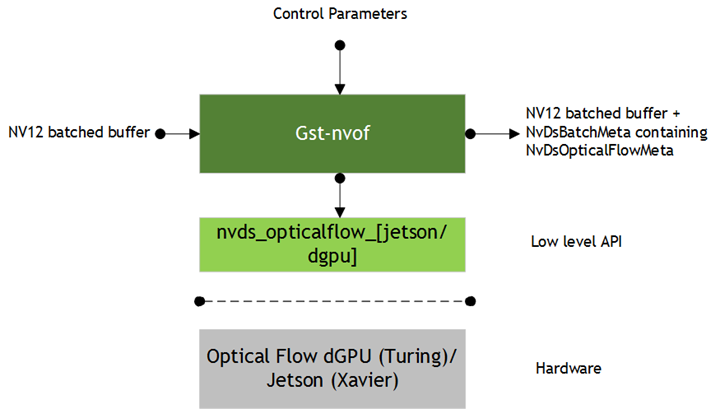Gst-nvof#
NVIDIA GPUs, starting with the dGPU Turing generation (except TU117 GPU) and Jetson Orin generation, contain a hardware accelerator for computing optical flow. Optical flow vectors are useful in various use cases such as object detection and tracking, video frame rate up-conversion, depth estimation, stitching, and so on.
The Gst-nvof plugin collects a pair of NV12 images and passes it to the low-level optical flow library. The low-level library returns a map of flow vectors between the two frames as its output.
The map of flow vectors is encapsulated in the NvDsOpticalFlowMeta structure and is added as a user meta with meta_type set to NVDS_OPTICAL_FLOW_META. The user meta is added to the frame_user_meta_list member of NvDsFrameMeta.
For guidance on how to access user metadata, see User/Custom Metadata Addition Inside NvDsMatchMeta and Tensor Metadata.

Note
Flow vectors are bi-dimensional vector and each component of flow vector is stored using S10.5 in a fixed-point representation of a 16-bit number. Structure NvOFFlowVector is used to store Flow Vector.
/**
* Holds motion vector information about an element.
*/
typedef struct _NvOFFlowVector
{
/** Holds the motion vector X component. */
gshort flowx;
/** Holds the motion vector Y component. */
gshort flowy;
} NvOFFlowVector;
MSB specifies the sign bit, the next 10 bits specify the integer value and the last 5 bits represent the fractional value of the flow vector. HW support only quarter pixel resolution and only the first 2 bits from 5 available fraction bits are used. We can convert the flow vector from fixed-point representation to floating-point using the following formula.
NvOFFlowVector output;
float32_t flow_vector.x = output.flowx/32.0f;
float32_t flow_vector.y = output.flowy/32.0f;
Inputs and Outputs#
Inputs
GStreamer buffer containing NV12 frame(s)
Control parameters
gpu-id: selects the GPU ID (valid only for dGPU platforms)
dump-of-meta: enables dumping of optical flow map vector into a .bin file
preset-level: sets the preset level
pool-size: sets the pool size
grid-size: sets the grid size
Outputs
GStreamer buffer containing NV12 frame(s)
NvDsOpticalFlowMeta metadata
Features#
The following table summarizes the features of the plugin.
Feature |
Description |
Release |
|---|---|---|
Configure GPU selection |
Sets the gpu ID to be used for optical flow operation (valid only for dGPU platforms) |
DS 4.0 |
Configure dumping of optical flow metadata |
Enables dumping of optical flow output (motion vector data) |
DS 4.0 |
Configure preset level |
Sets the desired preset level |
DS 4.0 |
Configure grid size |
Sets the flow vector block size |
DS 4.0 |
Gst Properties#
The following table describes the Gst properties of the Gst-nvof plugin.
Property |
Meaning |
Type and Range |
Example Notes |
|---|---|---|---|
gpu-id |
Device ID of the GPU to be used for decoding (dGPU only). |
Integer, 0 to 4,294,967,295 |
gpu-id=0 |
dump-of-meta |
Dumps optical flow output into a .bin file. |
dump-of-meta=1 |
|
preset-level |
Selects a preset level, default preset level is 0 i.e. NV_OF_PERF_LEVEL_FAST Possible values are: 0 (NV_OF_PERF_LEVEL_FAST): high performance, low quality. 1 (NV_OF_PERF_LEVEL_MEDIUM): intermediate performance and quality. 2 (NV_OF_PERF_LEVEL_SLOW): low performance, best quality (valid only for dGPU platforms). |
Enum, 0 to 2 |
preset-level=0 |
grid-size |
Selects the grid size. The hardware generates flow vectors blockwise, one vector for each block of 4×4 pixels. Currently only the 4x4 grid size is supported. |
Enum, 0 |
grid-size=0 |
pool-size |
Sets the number of internal motion vector output buffers to be allocated. |
Integer, 1 to 4,294,967,295 |
pool-size=7 |